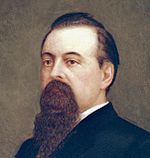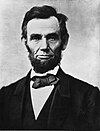This is an old revision of this page, as edited by 68.173.95.177 (talk) at 03:59, 5 July 2009. The present address (URL) is a permanent link to this revision, which may differ significantly from the current revision.
Revision as of 03:59, 5 July 2009 by 68.173.95.177 (talk)(diff) ← Previous revision | Latest revision (diff) | Newer revision → (diff) Ethnic groupWhite American (often used interchangeably with "Caucasian American" and within the United States simply "white") is an umbrella term officially employed by the United States Census Bureau, Office of Management and Budget and other U.S. government for the classification of United States citizens or resident aliens "having origins in any of the original people of Europe, the Middle East, or North Africa".
German (17%), Irish (12.1%), English Americans (9.4%), Spanish Americans (From Spain, non-Hispanic) (8.2%), Italian Americans (6%), Scottish Americans (4%), French Americans (4%), Polish Americans (3%), and Dutch Americans (3%) make up 66.7% of the "White" population.
Whites form the far majority of the US population with 74% of the population. Whites are regarded as the socially and demographically dominant racial group in the United States.
Historical and present definitions
Main article: Definitions of whiteness in the United StatesToday, the term "white American" can encompass many different ethnic groups. Although the United States Census purports to reflect a social definition of race, the social dimensions of race are more complex than Census criteria.
Current U.S. Census definition
The 2000 U.S. census states that racial categories "generally reflect a social definition of race recognized in this country. They do not conform to any biological, anthropological or genetic criteria." It defines "white people" as "people having origins in any of the original people of Europe, the Middle East, or North Africa. This also includes national and regional ancestries where these people contributed to the demographic make-up; Canadian, Latin American, Oceanian, and African ancestries for instance. In U.S. census documents, the designation white overlaps, as do all other official racial categories, with the term Hispanic, which was introduced in the 1980 census as a category of ethnicity, separate and independent of race.

Hispanicity is the only ethnic category, as opposed to racial category, which is officially collated by the U.S. Census Bureau. By definition, the term 'Hispanic' does not include the people of Spain. The distinction made by government agencies for those within the population of any official race category, is between those with Spanish backgrounds and all others of Hispanic ethnic backgrounds. These two groups are distinct and separate. Those of Spanish descent are white whose ancestory is directly traced to the people of Spain. Hispanics, on the other hand, consist of a racially diverse collection of other groups of Latin America that includes indigenous native South American and/or black peoples.
Many Americans who are treated as part of minority groups are included in the census category "white." This is true for many Latin Americans (Hispanic), 47.9% of whom identified racially as white. The 2000 Census separated the question on Hispanics from the question on race, the latter being divided into the 5 categories of white, black or African American, American Indian and Alaska Native, Native Hawaiian or other Pacific Islander, Asian American, plus "other", with the respondent having the ability to mark more than one category. It is also true for many Arab and other Middle Eastern Americans and North African Americans, as well as non-European Jewish Americans, since the 2000 Census conflates race and geographic/national origin: white is defined to include people with original origins in Europe, the Middle East and North Africa, or Asia
In cases where individuals do not self-identify, the U.S. census parameters for race give each national origin a racial value. Additionally, people who reported Muslim (or a sect of Islam such as Shi'ite or Sunni), Jewish, Zoroastrian, Mexican, or Caucasian as their "race" in the "Some other race" section, without noting a country of origin, are automatically tallied as white. The US Census considers the write-in response of "Caucasian" or "Aryan" to be a synonym for white in their ancestry code listing.


Social definition
According to race scholars such as Karen Brodkin, in the United States, essentially anyone of European descent is considered white and Jews are also considered white. However, European and even many Jewish scholars themselves do not consider those derived from Jewish ancestry of being white. Rabbi Professor Leonard J. Fein has stated publicly that Jews are not white. Likewise, while people of Middle Eastern and North African descent are included in the white category in the census, studies have found that Arab American teenagers may sometimes construct identities that distinguish themselves from "white society."
Some American white people, mainly those of distant descent from multiple European countries, tend to see themselves as belonging to no ethnic group at all, but just "American."
The cultural boundaries separating white Americans from other racial or ethnic categories have changed significantly over the course of American history. Even among Europeans, those not considered white at some time in American history are the Ashkenazi Jews, Germans, Irish, Italians, Slavs, Greeks, and other European people. David R. Roediger argues that the construction of the white race in the United States was an effort to mentally distance slave owners from slaves. The process of officially being defined as white by law often came about in court disputes over pursuit of citizenship.




Position within society
As whites are the dominant racial and cultural group; according to sociologist Steven Seidman writing about the most prominent perspective among researches, "White culture constitutes the general cultural mainstream, causing non-White culture to be seen as deviant, in either a positive or negative manner. Moreover, Whites tend to be disproportionately represented in powerful positions, controlling almost all political, economic and cultural institutions." Yet, according to Seidman, Whites are most commonly unaware of their "privilege" and the manner in which their culture has always been dominant in the US, as they do not identify as members of a specific racial group but rather incorrectly perceive their views and culture as "raceless," when in fact it is ethno-national (ethnic / cultural) specific with a racial base component.

Demographic information
Main article: United States Census, 2000| white Americans 1790-2000 | |||||
|---|---|---|---|---|---|
| Year | Population | % of the U.S | Year | Population | % of the U.S |
| 1790 | 3,172,006 | 80.7 | 1900 | 66,809,196 | 87.9 |
| 1800 | 4,306,446 | 81.1 | 1910 | 81,731,957 | 88.9 |
| 1810 | 5,862,073 | 81.0 | 1920 | 94,820,915 | 89.7 |
| 1820 | 7,866,797 | 81.6 | 1930 | 110,286,740 | 89.8 (highest) |
| 1830 | 10,532,060 | 81.9 | 1940 | 118,214,870 | 89.8 (highest) |
| 1840 | 14,189,705 | 83.2 | 1950 | 134,942,028 | 89.5 |
| 1850 | 19,553,068 | 84.3 | 1960 | 158,831,732 | 88.6 |
| 1860 | 26,922,537 | 85.6 | 1970 | 177,748,975 | 87.5 |
| 1870 | 33,589,377 | 87.1 | 1980 | 188,371,622 | 83.1 |
| 1880 | 43,402,970 | 86.5 | 1990 | 199,686,070 | 80.3 |
| 1890 | 55,101,258 | 87.5 | 2000 | 211,460,626 | 75.1 |
White Americans are the largest racial group counted in the 2000 Census, comprising 75.1% of the population. This number is sometimes recorded as 77.1% when it includes about 2% of the population who self-identified as "white" in combination with one or more other races; about 6% also identified ethnically as Hispanic. The largest ethnic groups (by descent) among white Americans were Germans, followed by the Irish and the English.
While over ten million white people can trace part of their ancestry back to the pilgrims who arrived on the Mayflower in 1620 (this common statistic overlooks the Jamestown, Virginia foundations of America and roots of even earlier colonist-descended Americans), over 50 million whites have at least one ancestor who passed through the Ellis Island immigration station, which processed arriving immigrants from 1892 until 1954. See also: European Americans.
Today, 62 per cent of white Americans are of British Isles descent (i.e. English, Welsh, Irish, Scottish). Fifteen per cent of whites are of entirely German ancestry, although 30 per cent are entirely or partly of German origin. Eighty-six per cent of white Americans today are of Northwestern European ancestry, and 14 per cent are of Southern or Eastern European descent.
In 2005, Whites made up 76% of the American population.

White Americans are projected to remain the majority, though with their percentage decreasing to 73% of the total population by 2050.


Geographic distribution

According to the Census definition, white Americans are the majority racial group in almost all of the United States. They are not the majority in Hawaii, many American Indian reservations, parts of the South known as the Black Belt, and in many urban areas throughout the country.
Overall the highest concentration of those referred to as white alone by the Census Bureau was found in the Midwest, New England, the Rocky Mountain states, Kentucky, and West Virginia. The lowest concentration of whites was found in southern and mid-Atlantic states.

Although all large geographical areas are dominated by white Americans, much larger differences can be seen between specific parts of large cities.
States with highest percentage of American whites, as of 2007:
- Maine 95.5%
- New Hampshire 95.0%
- West Virginia 94.3%
- Iowa 92.9%
- Idaho 92.1%
- Wyoming 91.6%
- North Dakota 90.9%




Income and educational attainment
Main article: Affluence in the United States § Race Further information: Personal income in the United States and Household income in the United States personal and household income in the United States Census in 2005White Americans have the second highest median household income and personal income levels in the nation. The median income per household member was also the highest, since white Americans had the smallest households of any racial demographic in the nation. In 2006, the median individual income of a white American age 25 or older was $33,030, with those who were full-time employed between ages 25 and 64 earning $34,432. Since 42% of all households had two income earners, the median household income was considerably higher than the median personal income, which was $48,554 in 2005. Among whites, Jewish Americans rank first in household income, personal income and educational attainment among white Americans . In 2005, white households had a median household income of $48,977, 10.3% above the national median of $44,389. Cuban Americans with 85% classifying as white, have a higher median income and educational attainment level than most other whites.
Poverty rates for white Americans are the second-lowest of any racial group, with 10.8% of white individuals living below the poverty line (3% below the national average). However, due to whites' majority status, 48% of Americans living in poverty are white.
Whites' educational attainment are the second-highest in the country, after Asian Americans'. Overall, nearly one-third of white Americans had a Bachelor degree, with the educational attainment for whites being higher for those born outside the United States. Nearly forty percent, 37.6%, of foreign born and 29.7% of native born whites had a college degree. Both figures are above the national average of 27.2%.
Gender income inequality was the greatest among whites with white men outearning white women by 48%. Census Bureau data for 2005 reveals that the median income of white females was lower than that of males of all races. In 2005, the median income for white females was only slightly higher than that of African American females, indicating that income inequities seem to run along gender lines more so than along racial lines.



Ethnic white neighborhoods
Many later European and Middle-Eastern immigrants, upon their arrival in the United States, felt isolated from the mainstream, Anglo-Saxon Protestant American society due to language, religious, and cultural barriers. They overcame this disadvantage by quickly creating closely-knit neighborhoods of members of their own ethnic groups. Such neighborhoods often grew into large, self-contained districts with their own churches and shops bearing signs in their own native languages; the most notable of these ethnic white districts were New York's Little Italy, Hamtramck in Michigan, the Irish Channel in New Orleans, Little Canada, Minnesota in the Minneapolis-St. Paul area; and the modern day Amish communities in Pennsylvania, as well as the Orthodox and Hasidic Jewish communities in Brooklyn's Borough Park.
Admixture
See also: Race and geneticsAccording to a recent study, about 30% of all White Americans, approximately 66 million people, have between 2 and 20% of African admixture with an exact median of 2.3%, which means the African median admixture percentage for all White population of the United State is 0.69%. Some whites have varying amounts of Native American ancestry; this admixture is claimed by white celebrities such as Chuck Norris, Cher, Megan Fox, Johnny Depp and Jessica Biel. Jennie Jerome, the mother of British Prime Minister, Sir Winston Churchill was rumored to have had an Iroquois great-grandfather.Elvis Presley had partial Cherokee Indian ancestry. There are also some white people who are or were descendants of Pocahontas, including First Ladies Edith Wilson and Nancy Reagan, astronomer Percival Lowell, as well as Wallis, Duchess of Windsor, the wife of King Edward VIII of the United Kingdom.
Image gallery
-
 English immigrants celebrate their first thanksgiving at Plymouth Colony
English immigrants celebrate their first thanksgiving at Plymouth Colony
-
 Daniel Boone leading settlers through the Cumberland Gap in 1775.
Daniel Boone leading settlers through the Cumberland Gap in 1775.
-
 Alice Heine, Princess of Monaco was born in New Orleans of German and French descent.
Alice Heine, Princess of Monaco was born in New Orleans of German and French descent.
-
 The Hatfield family of West Virginia in the late 19th century.
The Hatfield family of West Virginia in the late 19th century.
-
 Virginie Amélie Avegno Gautreau, better known as Madame X was of French ancestry.
Virginie Amélie Avegno Gautreau, better known as Madame X was of French ancestry.
-
 A white cowboy in the American west, c.1888
A white cowboy in the American west, c.1888
-
 Immigrant Lapp children at Ellis Island in the early 1900s.
Immigrant Lapp children at Ellis Island in the early 1900s.
-
 Family of Armenian immigrants, c.1908.
Family of Armenian immigrants, c.1908.
-
 Playwright Arthur Miller was of Polish-Jewish descent.
Playwright Arthur Miller was of Polish-Jewish descent.
-
 Russian-American actress Natalie Wood
Russian-American actress Natalie Wood
-
 An Irish-American family in Los Angeles, California, 1965.
An Irish-American family in Los Angeles, California, 1965.
-
 A group of white American college girls in Tennessee, c.1970
A group of white American college girls in Tennessee, c.1970
-
 Amish women in Lancaster County, Pennsylvania.
Amish women in Lancaster County, Pennsylvania.
- Turkish-Americans at the 27th annual Turkish Day Parade in New York, 2008. Turkish-Americans at the 27th annual Turkish Day Parade in New York, 2008.
-
Surfing is a popular sport for many white Americans who live in Florida, California, and Hawaii.
See also
|
| European Americans | |
|---|---|
| Central Europe | |
| Eastern Europe | |
| Northern Europe | |
| Southeast Europe | |
| Southern Europe | |
| Western Europe | |
| Other Europeans | |
| By region | |
| Middle Eastern Americans | |
|---|---|
| By nation | |
| By ethnicity | |
| By location | |
| White people | |||||||||||
|---|---|---|---|---|---|---|---|---|---|---|---|
| |||||||||||
| European emigration by location |
| ||||||||||
| Historical concepts | |||||||||||
| Sociological phenomena and theories | |||||||||||
| Negative stereotypes of Whites | |||||||||||
| White identity politics | |||||||||||
References
- U.S. Census Bureau; ; Data Set: 2007 American Community Survey; Survey: 2007 American Community Survey. Retrieved 2008-01-24
- Lee, Sandra S. Mountain, Joanna. Barbara, Koening A. The Meanings of Race in the New Genomics: Implications for Health Disparities Research. Yale University. 2001. Accessed October 26, 2006.
- The U.S. Census Bureau, for example, uses "white" rather than "white American." "Racial and Ethnic Classifications Used in Census 2000 and Beyond". Retrieved 2006-10-05.
- Definition of a White person in US and UK
- Revisions to the Standards for the Classification of Federal Data on Race and Ethnicity
- http://www.indopedia.org/Hispanic_American.html
- http://uk.answers.yahoo.com/question/index?qid=20090529132145AA0CDnG
- http://www.earlham.edu/~span/
- http://www.diversityinc.com/public/972.cfm
- Questions and Answers for Census 2000 Data on Race from U.S. Census Bureau, 14 March 2001. Retrieved 15 October 2006.
- http://www.census.gov/prod/2001pubs/c2kbr01-4.pdf The White Population: 2000, Census 2000 Brief C2KBR/01-4, U.S. Census Bureau, August 2001.
- Overview of Race and Hispanic Origin 2000 U.S. Census Bureau
- http://answers.yahoo.com/question/index?qid=20080423162131AA95coY
- http://www.trustedtranslations.com/spanish-language/translation/us-spanish.asp
- Surveillance Epidemiology and End Results. Race and Nationality Descriptions from the 2000 US Census and Bureau of Vital Statistics. 2007. May 21, 2007.
- University of Michigan. Census 1990: Ancestry Codes. August 27, 2007.
- Karen Brodkin, How Jews Became White Folks and What That Says About Race in America (New Brunswick NJ, 1998).
- http://www.laborlawtalk.com/showthread.php?t=49456
- http://www.diversityinc.com/public/972print.cfm
- http://www.urbandictionary.com/define.php?term=hispanic
- http://news.ronatvan.com/2009/05/23/jews-are-not-white-so-says-rabbi-prof-leonard-j-fein/
- http://metadave.wordpress.com/2007/06/08/jews-are-not-white-anthropology/
- Caliber - Sociological Perspectives - 47(4):371 - Abstract
- John Tehranian, "Performing Whiteness: Naturalization Litigation and the Construction of Racial Identity in America," The Yale Law Journal, Vol. 109, No. 4. (Jan., 2000), pp. 825-827.
- Roediger, Wages of Whiteness, 186; Tony Horwitz, Confederates in the Attic: Dispatches from the Unfinished Civil War (New York, 1998).
- Sweet, Frank W. Legal History of the Color Line: The Notion of Invisible Blackness. Backintyme Publishers (2005), ISBN 0939479230.
- Seidman, S. (2004). Critical Race Theory. In Contested Knowledge: Social Theory Today (pp. 231 - 243). Malden, MA: Blackwell Publishing.
- Official census statistics of the United States race and Hispanic origin population
- [http://factfinder.census.gov/servlet/QTTable?_bm=y&-qr_name=DEC_2000_SF1_U_QTP3&-ds_name=DEC_2000_SF1_U&-CONTEXT=qt&-redoLog=false&-_caller=geoselect&-geo_id=01000US&-format=&-_lang=en Census 2000 Summary File 1 (SF 1) 100-Percent Data Geographic Area: United States]
- http://www.infoplease.com/ipa/A0762156.html
- "United States Population Projections By Race and Hispanic Origin: 2000 TO 2050" (Excel). United States Census Bureau. Retrieved 2008-05-05.
- Brewer, Cynthia (2001). Census 2000, The Geography of US Diversity. Redlands, CA: ESRI Press.
{{cite book}}: Unknown parameter|coauthors=ignored (|author=suggested) (help) - "Distribution of those identifying as White alone, by state, US Census Bureau". Retrieved 2006-10-05.
- "US Census Bureau, Whites in the 2000 Census" (PDF). Retrieved 2006-10-05.
- United States -- States; and Puerto Rico: Percent of the Total Population Who Are White Alone 2007
- Pew Hispanic center.
- "Income, Poverty, and Health Insurance Coverage in the United States: 2004" (PDF).
- Rural Poverty: Myths and Realities
- "US Census Bureau report on educational attainment in the United States, 2003" (PDF). Retrieved 2006-12-23.
- "US Census Bureau, Personal income forum, Age 25+, 2005". Retrieved 2007-01-20.
- Our First Black President?, New York Times, retrieved on 2 April 2009
- Afro-European Genetic Admixture in the United States, Frank Sweet
- Ralph G. Martin, Jennie: The Life of Lady Randolph Churchill- The Romantic Years, 1854-1895, pp.15-16
- Ralph G. Martin, The Woman He Loved, pp. 9, 173
External links
- White Population 2000 from the US Census













